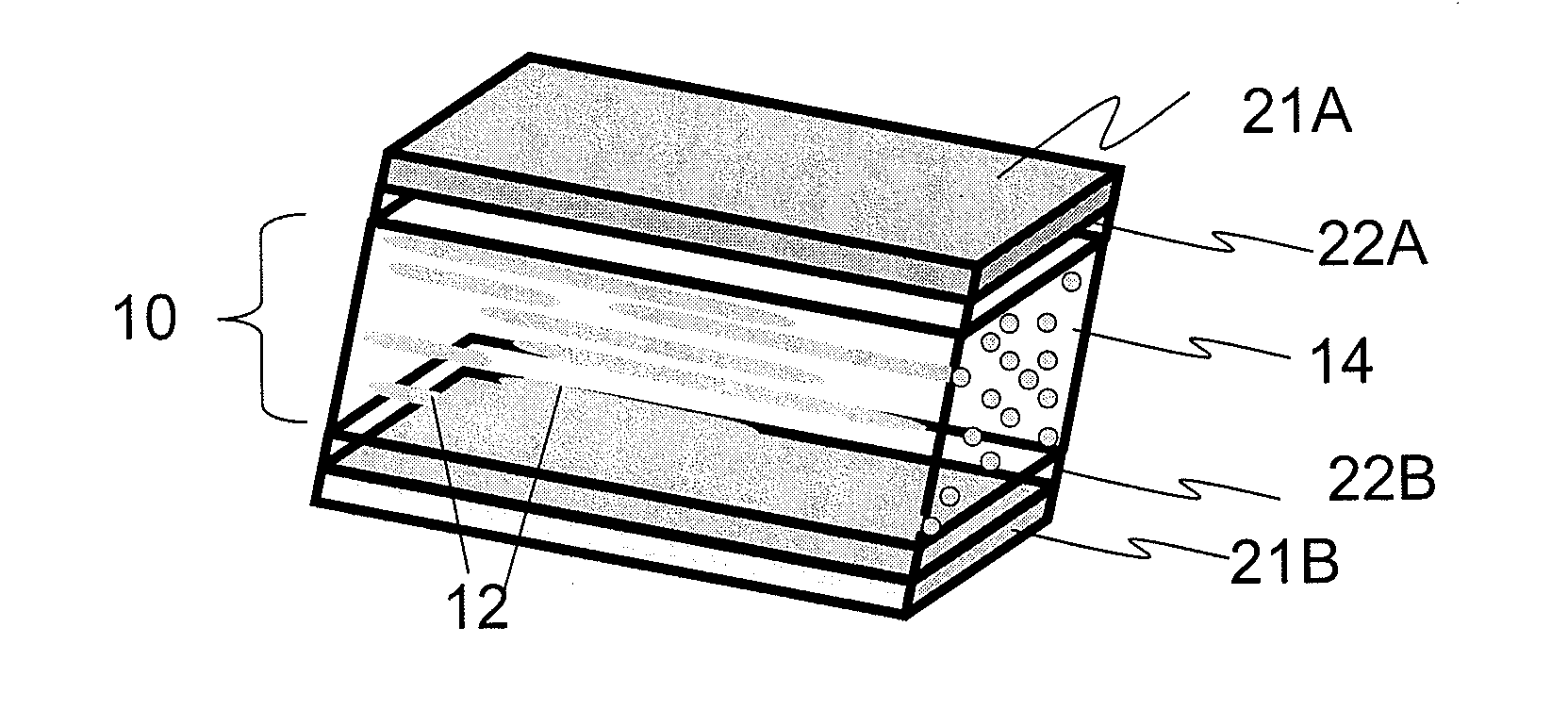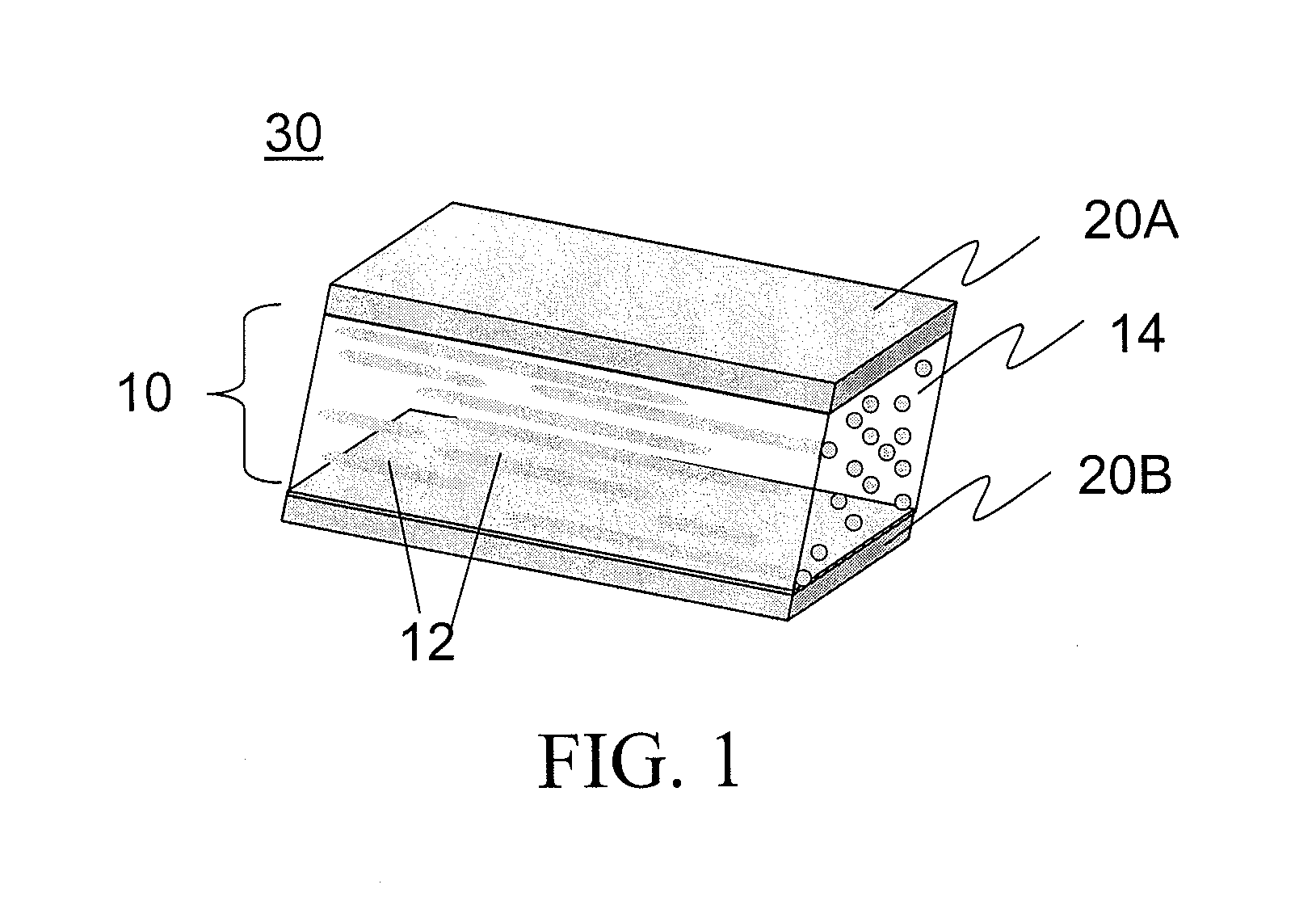Method of manufacturing a diffusely-reflecting polarizer having a nearly isotropic continuous phase
a diffusely-reflecting polarizer and continuous phase technology, applied in the field of diffusely-reflecting polarizers, can solve the problems of poor adhesion between inorganic particles and polymer matrix, and inability to achieve optical properties
- Summary
- Abstract
- Description
- Claims
- Application Information
AI Technical Summary
Benefits of technology
Problems solved by technology
Method used
Image
Examples
example 1
[0048]Pure continuous phase polymers Topas 8007, SB, Zylar 631, PETG 6763, and PCTG 5445 were coextruded with protective layers PET or PEN, and were stretched under the same conditions as the blends comprising the continuous and the disperse phases, i.e., at the same stretching temperature and the same stretching ratio. The skin layers were then peeled off. The refractive indices npara, nperp, and nz of each core layer consisting of pure amorphous polymer were then measured using the Metricon Prism Coupler 2010 from Metricon Corporation determined at the wavelength of 633 nm. The refractive indices npara, nperp, and nz correspond to the directions parallel to the stretching direction, perpendicular to the stretching direction, and along the sheet thickness direction, respectively. All the three indices nperp, and nz are very close to each other, with the difference between any two of them is less than 0.02, and the difference in most cases was smaller than 0.005. The refractive indi...
example 2
[0049]70% wt. Zylar 631 as the continuous phase polymer, 30% wt. PEN as the dispersed polymer, protective layer PEN, stretched 5× in the extruded film direction at a temperature of 125° C. This sample had an FOM value of 1.66 and had a total reflectivity of 83%, a diffuse reflectivity of 71% and a specular reflectivity of 12% (all measured at 550 nm).
[0050]Example 3
[0051]60% wt. PETG 6763 as the continuous phase polymer and 40% wt. PEN as the dispersed polymer, stretched 5× in the direction perpendicular to the extruded film direction at a temperature of 132° C. This sample had an FOM value of 1.43 and had a total reflectivity of 73%, a diffuse reflectivity of 62% and a specular reflectivity of 11% (all measured at 550 nm).
example 4
[0052]60% wt. PETG 6763 as the continuous phase polymer, 40% wt. PEN as the dispersed polymer, and 0.032 parts per hundred phosphoric acid added as a stabilizer (transesterification inhibitor), stretched 5× in the direction perpendicular to the extruded film direction at a temperature of 129° C. This sample had an FOM value of 1.37 and had a total reflectivity of 76%, a diffuse reflectivity of 61% and a specular reflectivity of 15% (all measured at 550 nm). Examples 2-4 demonstrate that reflective polarizers of the invention provide reflectivity that is predominantly diffuse in nature and satisfy the conditions that the diffuse reflectivity is greater than 50% and FOM is greater than 1.35.
Impact of Disperse Polymer Weight Percent
[0053]Continuous phase polymer Topas 8007, disperse polymer Eastar 7352, protective layer Eastar 7352, stretching ratio 4× at temperature 95° C. for 3 minutes soak time.
TABLE 1-1ExamplePET WeightNo.PercentFOM551.126101.127151.218301.439501.42
[0054]Continuous...
PUM
| Property | Measurement | Unit |
|---|---|---|
| Fraction | aaaaa | aaaaa |
| Fraction | aaaaa | aaaaa |
| Thickness | aaaaa | aaaaa |
Abstract
Description
Claims
Application Information
 Login to View More
Login to View More - R&D
- Intellectual Property
- Life Sciences
- Materials
- Tech Scout
- Unparalleled Data Quality
- Higher Quality Content
- 60% Fewer Hallucinations
Browse by: Latest US Patents, China's latest patents, Technical Efficacy Thesaurus, Application Domain, Technology Topic, Popular Technical Reports.
© 2025 PatSnap. All rights reserved.Legal|Privacy policy|Modern Slavery Act Transparency Statement|Sitemap|About US| Contact US: help@patsnap.com



